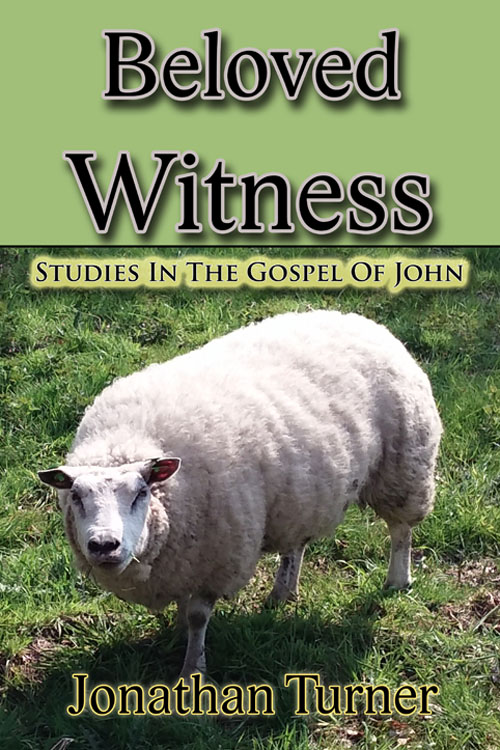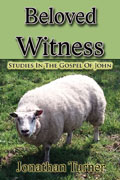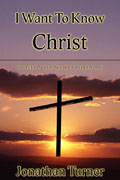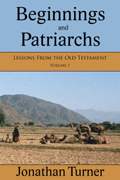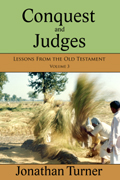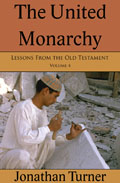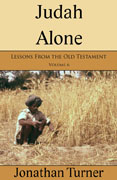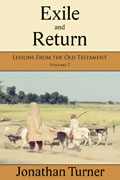Click on the cover image to order.
Table of Contents
Introduction
1 The Word Became Flesh
Supplemental Study: How God Communicates With Us
2 Behold The Lamb
Supplemental Study: Anticipating the Messiah
Supplemental Study: The Purpose For John’s Baptism
3 Come And See
Supplemental Study: Reckoning Time In John’s Gospel
4 The Best For Last
Supplemental Study: Was It Alcoholic?
5 Spring Cleaning
Supplemental Study: The Temple In Jerusalem
6 Wind Of Change
Supplemental Study: Baptism
7 Greater And Less
8 When Messiah Comes
Supplemental Study: The Samaritans
9 At His Word
Addendum: The Blindmen And The Elephant
10 Encounter At The Spa
11 Reasons To Believe
12 Dinner On The Grounds—A Stroll On The Lake
13 Manna From Heaven
Supplemental Study: This Is My Body, This Is My Blood
14 Priorities
Supplemental Study: Streams Of Living Water
15 Caught In The Act
Supplemental Study: A Genuine Account?
16 Who’s Your Daddy?
17 So That The Blind May See
18 Good Shepherd, Good Sheep
Supplemental Study: Shepherds Of The Flock
19 See The Glory
Supplemental Study: The Christ
20 The King Must Die!
21 The Hour Has Come
Supplemental Study: The Last Week Of Jesus’ Life
22 The Marks Of A Disciple
Supplemental Study: Representations Of The Last Supper
23 The Long Road Home
24 Remain In
25 The World Hates You
26 For Your Good
Supplemental Study: Waves Of Change
27 Complete Joy
28 Jesus’ Prayer For Us
29 Betrayed!
Supplemental Study: Two Betrayals, Two Different Outcomes
30 The King Must Die
31 It Is Finished
32 Seeing Is Believing
33 From Fisherman To Shepherd
Bibliography
About The Author
List of Illustrations
Gus
Dear Gus
Programmer’s Son
The Assyrian Empire
The Babylonian and Egyptian Empires
The Persian Empire
Alexander’s Empire
Seleucid and Ptolemaic Empires
The Roman Empire
Jesus’ Early Ministry
Herod’s Temple
The Wall Of Division
Jesus’ Early Ministry
From Judea to Galilee
The Divided Kingdom
The Feeding of the 5,000
The Last Supper—El Greco
The Last Supper—Da Vinci
Introduction
Our Bibles contain 4 books which we call Gospels. All of them are historical accounts of the remarkable Person named Jesus. They are not biographies in the sense we normally think of biographies. There are many details of Jesus’ life which they pass over in silence. Instead, they record those events which are particularly significant to salvation history.
The first 3 Gospels cover many of the same events, but from different perspectives. The intended audience of the Gospel of Matthew is primarily those who come from a Jewish background. Matthew emphasizes Jesus’ teaching rather than the miracles He performed. Matthew, more than the others, records what Jesus said. For example, his account contains the most complete version of the ‘Sermon on the Mount’ we have. One of the main messages of Matthew is that the Old Testament prophecies of the coming of a Messiah are fulfilled in Jesus.
Though Mark apparently wrote for believers, he took the time to explain Jewish customs. Therefore, in contrast to Matthew, his intended audience must have been Gentiles, that is believers who did not come from a Jewish background. In addition, he wrote using the speech of the common, worker class of Roman society. Mark emphasizes Jesus’ actions more than His teaching. The idea which unifies the entire book is that of service. Mark shows how Jesus served, focusing particularly on Jesus’ ultimate act of service—that of going to the cross. Since Jesus served, His followers must also be ready to serve, regardless of the cost.
Luke tells us the purpose of writing his Gospel. “…since I myself have carefully investigated everything from the beginning, it seemed good also to me to write an orderly account for you… so that you may know the certainty of the things you have been taught.” (Luke 1:3-4) In other words, Luke wrote for the benefit of believers. He wanted them to know that they could have confidence in the historical accuracy of the story of Jesus.
The Gospel of John is different than the other 3. While it, also, is grounded in history, the Gospel of John can be regarded as a supplement to the other Gospels. John not only relates events which are not found in the other Gospels, he focuses on the theological significance of the events. John, more than any of the others, emphasizes the identity of Jesus. Who is this Person through whom God offers salvation?
I. The Purpose Of John’s Gospel
John tells us his purpose in writing, “Jesus did many other miraculous signs in the presence of his disciples, which are not recorded in this book. But these are written that you may believe that Jesus is the Christ, the Son of God, and that by believing you may have life in his name.” (John 20:30-31) From these words it appears that John is writing for those who do not yet believe that Jesus is the Christ. However, John also seems to assume that his readers are already acquainted with the basic story of Jesus. It is like he is filling in the blanks the other Gospel writers left. So, who is John addressing? Is it those who do not believe that Jesus is the Christ, or those who do believe yet still have doubts—those whose faith is not yet complete?
Perhaps John’s intended audience is the latter. In more than one place in his account he shows how those who put their faith in Christ needed to move on to a higher and deeper faith. One of the most dramatic examples of this is John’s account of Thomas’ skepticism when he heard the other disciples say that Jesus had risen from the dead. Then, when confronted by the risen Christ, Thomas exclaimed “…My Lord and my God!” (John 20:28) In support of the view that John is writing to those who already believe, the footnote in the NIV translation points out that some manuscripts have the phrase “…these are written that you may continue to believe…”
On the other hand, John’s account makes it crystal clear that it is not enough to merely be acquainted with the story of Jesus. There were many who witnessed what Jesus did and heard Him teach, but refused to believe. They even acknowledged that the miracles were genuine, but still actively rejected Him (John 11:47-53). So it is quite possible that John writes for the informed skeptic. Perhaps the added detail, and his pointing out the theological significance of what Jesus did will be enough to move someone to genuine faith.
Regardless of the intended audience—whether it is those who already believe or those who don’t—John’s account is sufficient to move a person to faith. If someone reads and understands, yet still does not believe, it is not because there is a lack of information or evidence. As in the case of the chief priests’ and Pharisees’ reaction to Jesus raising Lazarus from the dead, their rejection of Christ results from a refusal to submit. They will not surrender self, and acknowledge Christ as Lord.
II. The Author
Who wrote this account of Jesus’ life? Why do we call it the Gospel of John? We would not even have to ask these questions if so-called ‘higher critics’ had not tried to cast doubt on the testimony from earliest times that the Apostle John is the one who penned this Gospel. Aside from plain statements from early sources such as the Muratorian Canon and the writer Irenaeus, there is internal evidence that the Apostle John is the writer.
One indication that John is the author is the absence of any mention of him by name. This follows the literary traditions of the time, that authors remained anonymous. Another bit of internal evidence is that John chapter 21, verses 20 through 24 clearly state that the “disciple whom Jesus loved” is the author. Looking at other mentions of the “beloved disciple” in John it seems obvious that he was one of the 3 who were in Jesus’ ‘inner circle.’ These were Peter, James and John. Of these 3, Peter cannot be the author because he is mentioned as being with the “beloved disciple” (for example, see John 20:2). Although James is not mentioned by name in the Gospel either, it is highly unlikely that he is the author because he was the first Apostle to die (Acts 12:2). In contrast, John chapter 21, verse 19 seems to imply that Peter’s martyrdom in his old age is already in the past. In light of these facts, there is no reason to doubt or question the understanding of the early church that the Apostle John is the writer of this Gospel.
III. Time And Place Of Writing
If the Gospel of John refers to Peter’s martyrdom as having occurred in the past, then it follows that it must have been written sometime after Peter’s two letters. Since Peter mentions Paul’s letters (2 Peter 3:15-16), John not only wrote after Peter did, but also after Paul. In this context, it is significant that in his letter to Philemon, Paul refers to himself as an “old man” (Philemon, verse 9). Acts chapter 7, verse 58 states that at the time of Stephen’s martyrdom Saul (that is, Paul) was a “young man.” Therefore, the Gospel of John must have been written a great many years after Stephen was stoned to death. It is highly probable that John’s Gospel is one of the last of the New Testament books written. Only John’s other writings—his 3 letters and the book of Revelation would have been written later.
From the cross, Jesus entrusted His mother, Mary, into John’s care and John took Mary into his own household (John 19:26-27). According to church tradition John, along with Mary, later emigrated from Palestine to the city of Ephesus in the Roman province of Asia (located on the western coast of modern Turkey). They most likely would have made the move to escape the war which culminated in the destruction of Jerusalem in 70AD. There is no reason to dispute this tradition. In fact, it is almost certain that at the time John was exiled to the island of Patmos, he was living in Ephesus. Early church historians also place him in Ephesus after his return from exile. In light of everything we know and can surmise, it is probable that John wrote this Gospel sometime around the years 80 to 85AD.
IV. Themes In John
Compared to the rest of the New Testament, the language of John’s Gospel is not complicated. The vocabulary is plain and simple. Beginning students of biblical Greek start with John because the sentences are easy to parse.
In spite of the simple language, John writes about some very profound concepts. It is probably accurate to say that John’s Gospel is more intellectual than the other 3. It engages our minds and causes us to think more deeply than the others do.
One of the major themes of the book is that of witness or testimony. The teaching of Jesus is not mere speculation or philosophy. Instead, it is based solidly on experience—the experience Jesus had with the Father before the incarnation. Similarly, the miracles Jesus performed were not merely acts of kindness; they bore testimony to the truth Jesus proclaimed (for example, see John 10:37-38). Personal experience and eyewitness testimony were crucial, not only in forming the disciples’ faith, but also to the message they would later proclaim (for example, see John 2:11, 19:26, 21:24). Later John would write, “That which was from the beginning, which we have heard, which we have seen with our eyes, which we have looked at and our hands have touched—this we proclaim concerning the Word of life.” (1 John 1:1)
Another important theme in John is that of light—particularly in contrast to darkness. John uses darkness as a metaphor for all that is wrong or evil. These are not mere abstractions; darkness is an active force which will enslave and destroy. One of the most arresting comments John makes is right after Judas left the ‘Last Supper’ in order to betray Jesus, “…And it was night.” (John 13:30) Only the light of Christ can dispel and destroy the darkness. Only Christ can illuminate and show us who we are and the direction we should go. Only the light of Christ can fill us with what is good and right.
Closely associated with the concept of light is that of truth. Truth has the power to set people free from the slavery of sin (John 8:31-34). Truth is essential to the kind of worship which God accepts (John 4:23-24). Jesus not only told the truth, He is the truth (John 14:6).
It is not enough to hear the truth, one must also believe it. Belief and faith are another of the major themes in John’s Gospel. John’s stated purpose for writing this Gospel is so that people will believe in Christ (John 20:31). A healthy faith is not static but grows with experience. John records several examples of people progressing in their faith (for example, in chapter 9 the case of the man born blind).
John also, more than any other of the Gospel writers, speaks of the Holy Spirit. Jesus gave the Spirit to His disciples to live within them, comfort and guide them and remind them of Christ’s teaching. The Spirit not only fills a vital role in the lives of Jesus’ followers, but in the lives of unbelievers. It is the Spirit who convicts the world and causes it to feel guilty of sin.
Another theme in John is life. Jesus is the true source of life. He came so that His followers can not only experience a new birth, but have abundant life. Another way to say it is that only in Jesus can people have life that is worth living. The abundant life which Jesus provides His followers is only a taste of the true life they will receive when He comes to take them to their eternal home.
A related concept to that of life, is transformation. Something which John clearly expresses is that, though he wishes to bring us to belief, belief by itself is not enough. What we know about Christ must also change us if our knowledge is of any use. Without transformation, no one will enter into the light and life which God wishes to give us. A proper relation to Jesus will transform us from being children of the devil to children of God.
Since John’s purpose in writing is to bring people to faith that Jesus is the Christ, it would be strange if he did not describe Jesus’ role as the Christ. John provides us with the context so we can understand several metaphors which Jesus used for Himself. As the ‘Bread of Life’ Jesus provides us with spiritual sustenance. As the ‘Water of Life’ Jesus quenches our spiritual thirst. As the ‘Good Shepherd’ Jesus leads us, His sheep, and lays down His life on our behalf.
Since John writes about Jesus’ identity and His character, it is fitting that another of the themes in this Gospel is glory. The concept of glory is difficult to grasp. As used in Scripture, the term is closely related to the attributes of God. However, it does not seem to refer to the attributes or characteristics of God, themselves, but rather to the manifestation or revealing of His character. Thus, when John writes, “This, the first of his miraculous signs, Jesus performed in Cana of Galilee. He thus revealed his glory, and his disciples put their faith in him.” (John 2:11) he seems to be saying that Jesus disclosed His divine nature by means of performing the miracle. However, the divine glory is also something which Jesus distributes to, or shares with, His followers (John 17:22). In other words, a result of believing in and accepting Jesus as the Christ, is that He transforms us and implants His divine characteristics within us. Then through our actions, words and attitudes we reveal or disclose Christ’s divine nature to others.
John is also concerned about time. The events of Jesus’ life and ministry were not random or governed by chance. On the contrary, they progressed according to a divine timetable. While recording several incidents John remarks that Jesus’ “time had not yet come” (for example, see John 7:30, 8:20). On some occasions Jesus Himself said that His “time had not yet come” (for example, see John 2:4, 7:6). On other occasions Jesus said the “time is coming” (for example, see John 4:21, 5:25, 16:2). Eventually, however, the appropriate time came (John 13:1, 17:1). At the right moment in the divine plan, Jesus offered Himself as the sacrifice needed to redeem mankind.
A Note About Time: We must be careful to use the appropriate system of reckoning time while reading John’s Gospel. The other Gospel writers apparently used the Jewish system of figuring the start of a new day at sunset. However, applying Jewish time to the Gospel of John creates several difficulties. Perhaps the most glaring of them is that if John wrote using Jewish time, he says that Pilate sentenced Jesus to death 3 hours after He was already crucified (compare John 19:14 with Mark 15:25). This difficulty disappears if John used Roman time (a new day begins at midnight). Reading John’s text according to the Roman system of reckoning time also resolves several other difficulties which will be mentioned in the appropriate place.
V. How The Book Is Organized
The mention of time leads to an observation about how John organized his material. John uses the Jewish festivals as a backdrop for much of what he presents. The context of the feasts and holy days helps us understand the meaning and significance of Jesus’ teaching on those occasions. The festivals also help us understand the sequence and the total length of Jesus’ earthly ministry.
John also used another device to order his material—he chose to mention specific miracles. The Jewish festivals help us understand the timing of Jesus’ ministry, the miracles help us understand Jesus’ nature. Each of the eight miracles (or signs) John records, reveals some significant aspect of Jesus’ identity or position. Each of these incidents calls for a response of faith. Some people believed as a result of the sign; others refused to believe in spite of the evidence.
Will we respond in faith, as John intended, or will we follow the lead of those who turned away from Jesus’ revealed glory?
The Word Became Flesh
John 1:1-18
Introduction: Since John’s purpose is to bring us to belief that Jesus is the Christ, it is appropriate that he tells us, right from the start, what Jesus’ true identity is. Though John’s account will concentrate on Jesus’ words and actions, Jesus transcends human experience. He is not a created being as we are. On the contrary, Jesus is divine and existed before nature.
I. In The Beginning (John 1:1-5)
John starts off by pointing out that before Jesus was born and became flesh, He existed as the creative Word. The first verse of John’s Gospel parallels the first statements in the entire Bible. “In the beginning God created the heavens and the earth… And God said, “Let there be…” And it was so.” (Genesis 1:1, 3, 11) Not only did God create the entire universe through His Word, the Word and God are one. To put it another way, the Word is God.
It follows that if the Word created the universe and everything in it, He also gave us life. Unfortunately, many people do not acknowledge their Creator; they do not recognize that their life comes from the Word. They think that life is self-generated or came into being without any divine agency. In verses 4 and 5 John writes, “In him was life, and that life was the light of men. The light shines in the darkness, but the darkness has not understood it.” Recognizing where our life comes from gives understanding and direction. Conversely, to not acknowledge that our life comes from the Word, plunges us into darkness. As stated in the Introduction to this commentary, John uses the word ‘darkness’ as a metaphor which stands for all that is wrong or evil. It is an active force which enslaves and destroys.
Translators are not entirely sure how to translate the last part of verse 5 because the word John uses has two meanings. Some translations say that the darkness doesn’t understand the light. This indicates that evil can never comprehend the nature of the Word and, therefore, of life. This gives us a test by which we can evaluate the claims of teachers. If someone says that he can teach us about life, or give us guidance about how to live, but is not living in the light given by the Word, he is lying. Instead of providing illumination he, himself, is in darkness.
Other translations say, “…and the darkness has not overcome it.” This indicates that the light is more powerful than darkness. Even if people try to ignore or suppress the Word, they will never succeed.
II. A Witness To The Light (John 1:6-9)
Since the Word, who is also God, was instrumental in the creation of the universe, we can learn some things about Him by observing nature. For example, the Apostle Paul writes, “For since the creation of the world God’s invisible qualities—his eternal power and divine nature—have been clearly seen, being understood from what has been made…” (Romans 1:20) We are awed by the power of the ocean waves, by the destructive energy of hurricanes, earthquakes and volcanoes. Even though we observe and experience them, the power that drives them is beyond our ability to grasp and comprehend. How much more awesome and majestic must be the One who spoke the universe into existence!
Though we can learn a few things about the Word by observing our environment, if that were all we had, the Creator would appear remote, impersonal and unknowable. As the prophet Job exclaimed, “…these are but the outer fringe of his works; how faint the whisper we hear of him! Who then can understand the thunder of his power?” (Job 26:14) However, throughout history God has chosen to reveal Himself to us by another means—through the word of the prophets. The Apostle Peter writes, “…you must understand that no prophecy of Scripture came about by the prophet’s own interpretation. For prophecy never had its origin in the will of man, but men spoke from God as they were carried along by the Holy Spirit.” (2 Peter 1:20-21) Through the prophets we learn not only about God’s power, but also about His personality and His will.
John the Baptist was one of the prophets who testified about God. However, there was a basic difference in John’s testimony compared to that of other prophets. John spoke as a witness of the light that was coming into the word. As we shall see further on in chapter 1, one of the purposes of John’s ministry was to identify the ‘light.’ It was he who first recognized that Jesus was God’s Son. It was he who identified Jesus as the One who would take away the sins of the world.
The purpose of John’s witness was not only to identify, but so that people would believe on the basis of his testimony. Luke writes, “All the people, even the tax collectors, when they heard Jesus’ words, acknowledged that God’s way was right, because they had been baptized by John. But the Pharisees and experts in the law rejected God’s purpose for themselves, because they had not been baptized by John.” (Luke 7:29-30)
The writer of this Gospel records an incident near the end of Jesus’ ministry which also shows the power of John the Baptist’s witness. “Then Jesus went back across the Jordan to the place where John had been baptizing in the early days. Here he stayed and many people came to him. They said, “Though John never performed a miraculous sign, all that John said about this man was true.” And in that place many believed in Jesus.” (John 10:40-42)
III. The Right To Become Children (John 1:10-13)
In verses 10 through 13, John contrasts those who do not receive the Word to those who do. They have different births. Those who do not receive are left as they were. Their’s is only the natural, physical birth which is common to all flesh. What are the spiritual consequences of not receiving the Word? The Apostle Paul writes, “The natural person does not accept the things of the Spirit of God, for they are folly to him, and he is not able to understand them because they are spiritually discerned.” (1 Corinthians 2:14 ESV) In other words, rejecting the Word makes it impossible to even understand spiritual things. As Jesus said, “Whoever has will be given more, and he will have an abundance. Whoever does not have, even what he has will be taken from him.” (Matthew 13:12)
In contrast to this, those who receive the Word are given a new birth. They are born of God. John will expand on the concept of the new birth in chapter 3 where he recounts Jesus’ conversation with Nicodemus. He will discuss spiritual parentage again in chapter 8. Being born of God is an extremely important concept which we will explore in more detail in the passages mentioned above. For now, simply note some of the results of this new birth. The Apostle Peter writes, “Praise be to the God and Father of our Lord Jesus Christ! In his great mercy he has given us new birth into a living hope through the resurrection of Jesus Christ from the dead, and into an inheritance that can never perish, spoil or fade—kept in heaven for you, who through faith are shielded by God’s power until the coming of the salvation that is ready to be revealed in the last time.” (1 Peter 1:3-5) It is because of the new birth, being born of God, that we have hope, an inheritance and salvation.
Notice one more thing in verse 12. There is a link between receiving the Word and belief. We cannot receive without belief. In fact receiving is equated with belief. We cannot be born of God without receiving the Word, and receiving the Word means that we believe it. There are a lot of people who claim that they are born of God, but who do not believe the Word. It doesn’t work that way. Belief always comes before the new birth.
IV. His Glory (John 1:14)
It would be extremely difficult to learn about God without the words of the prophets such as John the Baptist. But even that is not enough. Knowing about someone is a very different thing than knowing him. And so the Word became a man and subjected Himself to the same environment and limitations that we experience. The writer of Hebrews puts it this way, “The Son is the radiance of God’s glory and the exact representation of his being…” (Hebrews 1:3)
Verse 18 says, “No one has ever seen God, but God the One and Only, [or the Only Begotten] who is at the Father’s side, has made him known.” It is only God who can fully reveal God.
This is the message of the Bible: We are incapable of approaching God or comprehending Him. So, He descended to our level so that we might know Him, be reconciled to Him and, one day, be raised to His level. In other religions God sends down. In Christianity, God comes down.
But there is another dimension to God becoming flesh. Not only does it allow us to understand God as we never could otherwise, it also allowed God to understand and experience our problems. The writer of Hebrews explains, “For we do not have a high priest who is unable to sympathize with our weaknesses, but we have one who has been tempted in every way, just as we are—yet was without sin. Let us then approach the throne of grace with confidence, so that we may receive mercy and find grace to help us in our time of need.” (Hebrews 4:15-16)
V. The Fullness Of His Grace (John 1:15-18)
In verses 15 through 18 John contrasts the Law which God revealed through Moses, with the grace and truth which came through Christ. Notice that John identifies the Being he has been calling the Word, as Jesus Christ. Just as the Word is the source of life He, that is Jesus Christ, is also the source of grace. His grace is full and complete. It is inexhaustible.
John writes that “we have all received.” This most likely means that all who have received, that is accepted, the Word, receive grace and blessings in return.
John compares Moses and Jesus. It was through Moses that the Old Testament Law was given. Moses was not the Law, but was the mediator of it. In contrast, grace and truth were not given through Christ, but came through Christ. In other words, Christ is grace and truth. When Christ came into the world, grace and truth came into the world. This does not mean that the Law was not true. It surely was! Since God is true, anything given or commanded by Him is also true. However, we can say that the truth in the Law was abstract. Jesus is truth embodied.
There is another contrast here as well. The Law was given through Moses. The Law set out God’s expectations and requirements. By keeping the Law one could remain in a right relationship with God. The principle behind the Law was obedience. As God said, “Keep my decrees and laws, for the man who obeys them will live by them. I am the LORD.” (Leviticus 18:5)
But there was nothing in the Law to help a person keep the regulations. What if a person failed to keep even one of the rules? Once the covenant had been violated, there was no way to restore the broken relationship with God. This was the Law’s fatal weakness. Yes, there were sin offerings—lots and lots of sin offerings. But they could never really atone for sin. They were merely a promissory note, looking forward to the time when Someone would pay the accumulating debt.
In contrast to the Law, Christ brings grace. In the new arrangement in Christ; when someone has been granted the right of being born of God by receiving the Word; under the New Covenant, there is grace. What is grace? Grace is not only the undeserved blessings which we receive in Christ, it is also the means which enables us to keep the covenant. The Apostle Paul writes, “For the grace of God that brings salvation has appeared to all men. It teaches us to say “No” to ungodliness and worldly passions, and to live self-controlled, upright and godly lives in this present age,” (Titus 2:11-12) It is grace which provides inexhaustible blessings. It is grace which brings salvation. It is grace which enables us to live according to God’s will. It is made available to us only through Jesus Christ.
VI. Application Questions
1) Which side of the line are you on? Are you in the light, or are you still in darkness?
2) Have you received the Word, or have you rejected it?
3) Are you still trying to earn your salvation or trying to please God by keeping a set of rules which is beyond your ability to keep? Or, have you experienced the grace that comes only through Jesus Christ?
